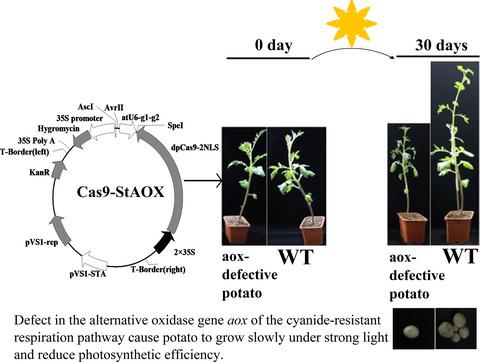当前位置:
X-MOL 学术
›
Plant Biol.
›
论文详情
Our official English website, www.x-mol.net, welcomes your
feedback! (Note: you will need to create a separate account there.)
The role of cyanide-resistant respiration in Solanum tuberosum L. against high light stress.
Plant Biology ( IF 4.2 ) Pub Date : 2020-03-06 , DOI: 10.1111/plb.13098 D Hua 1 , M Ma 1 , G Ge 1 , M Suleman 1 , H Li 1
Plant Biology ( IF 4.2 ) Pub Date : 2020-03-06 , DOI: 10.1111/plb.13098 D Hua 1 , M Ma 1 , G Ge 1 , M Suleman 1 , H Li 1
Affiliation

|
Cyanide-resistant respiration in potato mitochondria is an important pathway for energy dissipation. It can be activated by high light; however, it is unclear what roles cyanide-resistant respiration plays in the response to high light stress in potato. We designed a CRISPR vector for the functional gene StAOX of the potato cyanide-resistant respiratory pathway. Agrobacterium tumefaciens GV3101 was transformed into potato. Hydrogen peroxide level, MDA content, antioxidant activity and cyanide-resistant respiratory capacity of potato leaves under high light stress were determined. Photosynthetic efficiency and chlorophyll content were determined. In addition, the operation of the malate-oxaloacetate shuttle route and transcription level of photorespiration-related enzymes were also examined. The results showed that two base substitutions occurred at the sequencing target site on leaves of the transformed potato. Accumulation of ROS and increased membrane lipid peroxidation were detected in the transformed potato leaves and lower photosynthetic efficiency was observed. The transcription level of the malate-oxaloacetate shuttle route and photorespiration-related enzymes also significantly increased. These results indicate that the cyanide-resistant respiration is an important physiological pathway in potato in response to high light stress. It also suggests that plant cyanide-resistant respiration is closely related to photosynthesis. This implies the unexplored importance of plant cyanide-resistant respiration in plant photosynthesis, energy conversion and carbon skeleton formation.
中文翻译:

马铃薯耐高温抗氰化物的呼吸作用。
马铃薯线粒体中抗氰化物的呼吸是能量耗散的重要途径。它可以被强光激活;然而,尚不清楚抗氰化物呼吸作用在马铃薯对高光胁迫的响应中起什么作用。我们为马铃薯抗氰化物呼吸道的功能基因StAOX设计了CRISPR载体。将根癌农杆菌GV3101转化为马铃薯。测定了高光胁迫下马铃薯叶片的过氧化氢含量,MDA含量,抗氧化活性和抗氰呼吸能力。测定光合作用效率和叶绿素含量。另外,还检查了苹果酸-草酰乙酸穿梭途径的操作和光呼吸相关酶的转录水平。结果表明,在转化马铃薯叶片的测序靶位点发生了两个碱基取代。在转化的马铃薯叶片中检测到了ROS的积累和膜脂质过氧化的增加,并且观察到较低的光合作用效率。苹果酸-草酰乙酸穿梭途径和光呼吸相关酶的转录水平也显着增加。这些结果表明,抗氰化物的呼吸作用是马铃薯应对高光胁迫的重要生理途径。这也表明植物抗氰化物的呼吸作用与光合作用密切相关。这意味着在植物的光合作用,能量转化和碳骨架形成中,抗氰化物呼吸的重要性尚未得到探索。
更新日期:2020-03-06
中文翻译:

马铃薯耐高温抗氰化物的呼吸作用。
马铃薯线粒体中抗氰化物的呼吸是能量耗散的重要途径。它可以被强光激活;然而,尚不清楚抗氰化物呼吸作用在马铃薯对高光胁迫的响应中起什么作用。我们为马铃薯抗氰化物呼吸道的功能基因StAOX设计了CRISPR载体。将根癌农杆菌GV3101转化为马铃薯。测定了高光胁迫下马铃薯叶片的过氧化氢含量,MDA含量,抗氧化活性和抗氰呼吸能力。测定光合作用效率和叶绿素含量。另外,还检查了苹果酸-草酰乙酸穿梭途径的操作和光呼吸相关酶的转录水平。结果表明,在转化马铃薯叶片的测序靶位点发生了两个碱基取代。在转化的马铃薯叶片中检测到了ROS的积累和膜脂质过氧化的增加,并且观察到较低的光合作用效率。苹果酸-草酰乙酸穿梭途径和光呼吸相关酶的转录水平也显着增加。这些结果表明,抗氰化物的呼吸作用是马铃薯应对高光胁迫的重要生理途径。这也表明植物抗氰化物的呼吸作用与光合作用密切相关。这意味着在植物的光合作用,能量转化和碳骨架形成中,抗氰化物呼吸的重要性尚未得到探索。











































 京公网安备 11010802027423号
京公网安备 11010802027423号